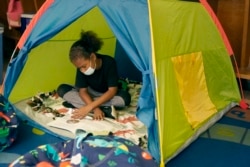Schools in the United States are using a large increase in federal money to help students’ mental health needs.
School systems, or districts, are given plenty of freedom on how to spend the federal money. But mental health problems among students had become clear. Districts have observed a rise in behavioral issues, signs of stress and absenteeism as students returned to classrooms this fall. For many, it was their first time back in a full classroom since the start of the COVID-19 pandemic.
In Kansas City, Kansas, educators are opening an after-school mental health center. The center is filled with counselors and social workers. Schools in Chicago, Illinois, have “care teams” with the mission of helping struggling students.
For some school districts, the money has aided long-standing work to help students deal with trauma -- difficult experiences that have led to emotional problems. Other school systems have created new efforts to treat students. Overall, the money puts public schools at the center of efforts to improve students’ general well-being.
When the government sent aid to schools after the 2008 economic recession, “this conversation wasn’t happening,” said Amanda Fitzgerald. She is with the American School Counselor Association. Now, Fitzgerald said, the discussion across the country is very centered on student well-being.
Last month, three major children’s health groups said the situation of children’s mental health should be considered a national emergency. The U.S. Education Department has pointed to the aid money as a chance to rethink how schools provide mental health support. Education Secretary Miguel Cardona said mental health needs to be at the center of recovery from the pandemic.
The pandemic aid to schools totals $190 billion. That is more than four times the amount the Education Department normally spends on kindergarten through 12th grade schools each year. Money for mental health services has gone toward worker training, mental health examinations and classroom lessons that include social and emotional learning.
Many districts have been working to hire more mental health experts. The National Association of School Psychologists questioned its members this fall. It found that more than half of districts were planning to add social workers, psychologists or counselors.
With $9.5 million of federal aid funding and outside grant money, Paterson schools in New Jersey added five behavioral experts. The district also hired two substance abuse experts and workers able to identify students going through crises.
Paterson is one of the poorest parts of New Jersey. Many of the 25,000 students there faced hunger even before the pandemic and struggled after family members lost jobs, said Superintendent Eileen Shafer.
“We wanted to make sure before we try to teach anything new, that we’re able to deal with where our children are right now based on what they’ve been through,” she said.
In Ellicottville, New York, school psychologist Joe Prior is seeing more anxiety among students. He said the district wants to use the aid to hire a counselor to connect students with psychological help.
Chicago, the nation’s third-largest school district, created a “healing plan” for students, using $24 million of its $2.6 billion in federal aid.
In Detroit, the district is spending $34 million on mental health programs. The school system is using the money to screen students, expand help from outside mental health providers, and offer extra support to parents.
On a recent Wednesday, that meant an hourlong meditation session for parents at a local coffee shop. One parent worried her own stress was affecting her son’s ability to learn.
“As a community we have all been through something,” said Sharlonda Buckman, an assistant superintendent who took part in the session. “Part of the recovery has to be some intentional work in spaces like this, so we can be there for our kids.”
I’m Dan Novak.
The Associated Press and Chalkbeat reported this story. Dan Novak adapted it for VOA Learning English. Ashley Thompson was the editor.
_______________________________________
Words in This Story
absent — adj. not present at a usual or expected place
counselor — n. a person who provides advice as a job
conversation — n. an informal talk involving two people or a small group of people :the act of talking in an informal way
kindergarten — n. a school or class for very young children
hire — v. to give work or a job to (someone) in exchange for wages or a salary
psychologist — n. a scientist who specializes in the study and treatment of the mind and behavior
anxiety — n. fear or nervousness about what might happen
meditation— n. the act or process of spending time in quiet thought
intentional — adj. done in a way that is planned or intended
kid — n. a young person











